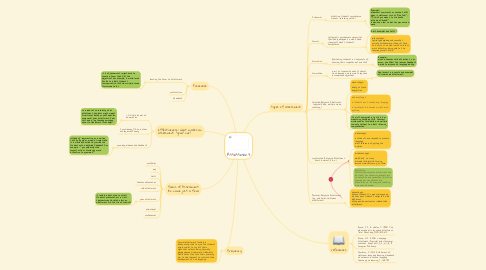
1. Procedure
1.1. choosing the form of assessment
1.1.1. it is of paramount importance to choose a from that fits the objectives. for example, it would sound foolish to assess students communicative skills via multiple-choice structured tests.
1.2. construction
1.3. feedback
2. forms of Assessment (to name just a few)
2.1. portfolios
2.2. logs
2.3. tests
2.4. teacher observation
2.5. self assessment
2.6. peer assessment
2.6.1. it could be best used to assess students' presentations in class. teachers may facilitate such an assessment via the use of rubricks
2.7. audiotapes
2.8. conferences
3. frequency
3.1. formal assessment should be infrequently used to give the students opportunities to try out their hypothesis without being formally judged,whereas informal assessments should never stop since their primarily aim to help learners to continue their development of the language.
4. effectiveness: what makes an assessment "good" one?
4.1. 1. Multiple sources of information
4.1.1. to increase the reliabilty of an assessment, teachers might weight final scores based on participation, homeworks, peer assessment, final test and a log thereby empoying various asseessment strategies!
4.2. 2. considering MI and other intellegences theory
4.3. providing elaborated feedback
4.3.1. instead of commenting on a writing task by "good" or giving a single score it is more effective to provide the student with a detailed feedback for example : " you perfectly used connectors but should pay more attention to grammar!"
5. types of assessment
5.1. Informal
5.1.1. assessing students competence without recording results
5.1.1.1. Examples: *teachers' comments on certain tasks given in classroom such as "Nice Job!", "I think you meant to use broke instead of break!". * advice on how to better pronounce a word
5.2. Formal
5.2.1. systematic procedures or exercises specificaly designed to make fixed judgments about students' competence.
5.2.1.1. best examples are tests !
5.2.1.2. disdvantages: typically degrading and provokes qnxiety. Furthermore, students tend to focus on the final results without much attention being paid to the learning process itself.
5.3. Furmative
5.3.1. Evaluating students in the process of forming their competencies and skills
5.3.1.1. Example: when a teacher calls attention to an error, he offers the learner feedback aimed to imrpove his language ability.
5.4. Summative
5.4.1. aims to summarize what students have learned and how well they have accomplished objectives.
5.4.1.1. final exams in a course are examples of summative assessment!
5.5. Selected-Response Assessment (e.gtrue/false, multiple choice, matching)
5.5.1. advantages: *easy to score *objective
5.5.2. disadvantages: * students don't create any language * sometimes it becomes a matter of guessing
5.5.3. it's most appropriate to use it for measuring receptive skills. teachers would prefer true/false and multiple choices questions to assess listening comprehension!
5.6. constructed-Response Assessment (short answers, fill-in)
5.6.1. advantages: * students are required to produce language *less likliehood of gussing the answer
5.6.2. disadvantages: *difficult to score *involves subjectivit scoring *more time-consuming to score
5.6.3. Application: Constructed-response assessment can be useful for observing interactions of receptive and productive skills< for example you can observe the interaction of listening and speaking in an oral interview.
5.7. Personal-Response Assessment (e.g. portfolios, self/peer assessment)
5.7.1. advantages: *allows students to produce language * allwos each student's response to be different. *they provide personal or indidualized assessment

